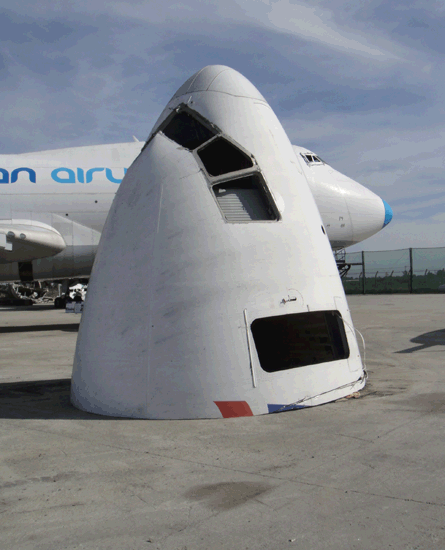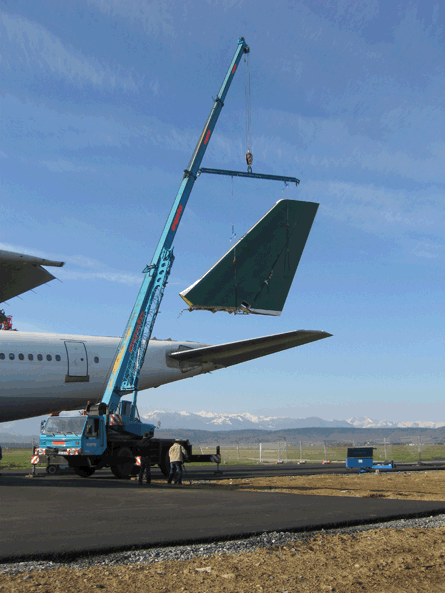Dismantling and recycling scrapped airliners is becoming big business. Estimates from the Aircraft Fleet Recycling Association (AFRA) put the number of aircraft destined for the junk yard over the next 20 years at 12,000, and pressure is growing to reduce significantly the amount of waste that goes to landfill.
Airbus and Boeing have their own initiatives to address this growing problem, but both are left scratching their heads when it comes to finding ways of recycling the materials used in aircraft interiors.
In mid-2010, AFRA, of which Boeing is a member, set an ambitious target for 90% of the materials salvaged from scrapped aircraft to be recycled - preferably into products in the aviation supply chain - by 2016. It also aims to cut the amount of aircraft manufacturing waste destined for landfill by 25% by 2012.
 |
|---|
© ChateaurouxAircraft interiors pose a problem when it comes to recycling materials |
"The industry standard for aircraft recycling depends on how efficient the company doing the recycling is - 60-75% if they're not separating the wiring from the aluminium or 80% if they are," says Bill Carberry, Boeing programme manager of aircraft and composite recycling. "The issue in terms of getting to a higher percentage is interiors. Most of it goes to landfill because it's a very difficult material to recycle."
Carberry adds that "if we solve interiors, we will hit 90% and it could be higher", but therein lies the problem. Boeing has spent "a couple of years" trying to come up with a recycling technology that works for interiors, but "we haven't had much success", Carberry admits.
A large part of the problem is that many aircraft are scrapped in parts of the world where recycling facilities do not exist and shipping is costly. Also, the material used in interiors - glassfibre, for example - does not have a high market value when recycled.
"We have tried looking at existing technologies from other industries as well as new recycling techniques," says Carberry, adding that Boeing is working on the issue with the UK's Nottingham University. However, this research is in the early stages and "is not mature enough to talk about".
RECYCLING SOLUTION
Boeing is now working on its own to research a recycling solution for interiors and is "not seeking any grant money" after the rejection of a proposal it put forward to Bartin Aero Recycling and Veolia Environmental Services. Progress is slow on this front, but Boeing is now recycling certain types of waste.
"We're having pretty good success at recycling carbonfibre," says Carberry. "We're starting to collect manufacturing scrap from two facilities and sending it to Recycled Carbon Fibre in the UK." The process for producing carbonfibre is extremely energy intensive, with new carbonfibre taking 165kWh/kg (75kWh/lb) to make, compared with just 8.8kWh/kg to produce recycled carbonfibre.
Recycled carbonfibre is also cheaper, costing $17.60/kg compared with $44/kg for industrial-scale carbonfibre. However, the UK facility to which Boeing is shipping its carbonfibre is "the only commercial operation" of its kind in the world, with another such facility "coming up to speed in Japan", says Carberry. A further facility in the USA is also close to opening, but has yet to secure the necessary permits. "It's not very cost-effective to ship, but we're doing this to help develop an industry to create a commodity," he adds. "We're now trying to prove the process at our own expense."
 |
|---|
© ChateaurouxAFRA studies suggest that 12,000 aircraft will be recycled over the next 20 years |
In late 2009, Boeing reached out to its European rival, Airbus, to collaborate on developing technologies for recycling aircraft materials. This request followed an agreement signed at the 2008 Farnborough air show, under which the airframers pledged to work together more closely on environmental matters. However, it appears the two manufacturers are continuing to pursue their own courses of action.
For its part, Airbus took part in Pamela (Process for Advanced Management of End of Life Aircraft), an aircraft dismantling demonstration project supported by the European Commission's Life initiative. Pamela's aim was to demonstrate that, by 2015, 85% of an aircraft's parts could be reused, recovered or recycled in an environmentally friendly way.
In February 2006, a year-long operation began to dismantle an Airbus A300 at Tarbes airport in western France and test various processes for recycling its parts. Some 15% of the aircraft's weight ended up in landfill - a vast improvement on the 40-45% that would have been dumped previously. Most of that 15% related to materials found in the cabin.
Olivier Malavallon, Pamela project director and end-of-life dismantling expert for Airbus, says work is under way at Airbus's design office "to find alternative solutions to the current design of the cabin" in the hope that materials used in future aircraft interiors will be easier to recycle. For the time being, Malavallon believes it makes more sense to store discarded cabin components "in the most appropriate way" than to try to recycle them.
Once Pamela was completed and the results presented to the European Union, Airbus wasted no time in helping to establish its sequel: Tarmac Aerosave (Tarbes Advanced Recycling and Maintenance Aircraft). Tarmac, which comprises five industrial partners as well as Airbus, officially opened in February 2009 and has "outperformed its initial targets", says Malavallon.
Airbus predicts that at least 6,500 aircraft in the 100-plus passenger category will reach end of life over the next 20 years, and 1,500 of them will be Airbuses. Tarmac, whose aim is to industrialise the best practices identified by Pamela, will go some way towards dealing with these airliners as they head for the grave.
So far, 10 aircraft have been dismantled by Tarmac, not all of them Airbuses. The facility has also dealt with Fokker 100s, McDonnell Douglas DC-9s and Boeing 737-400s, and will soon "dismantle a much bigger aircraft from a US competitor", says Malavallon. Tarmac plans to dismantle 12 aircraft in 2011 but is sized to dismantle 20-30 airliners a year.
France is also home to another aircraft dismantling and recycling facility - the Chateauroux Air Centre, a member of AFRA. At Chateauroux, maintenance, repair and overhaul company Europe Aviation and Veolia subsidiary Bartin Aero Recycling take apart 10 to 12 airliners a year, a figure that is set to rise.
MORE AND MORE
"We've done studies that show 12,000 aircraft will be recycled in the next 20 years, including aircraft flying today and grounded aircraft," says Martin Fraissignes, AFRA executive director and general manager of Chateauroux. "Every year at Chateauroux we will recycle more and more aircraft."
About 70% of each aircraft dismantled at Chateauroux is recycled and, once again, "it's mainly the cabin that is not yet covered, so we're mainly focused on that", says Fraissignes. "Several research institutes are working on this but, for the time being, these materials are going to landfill."
With AFRA, Fraissignes is working on a global-scale aircraft-recycling project that he hopes will be launched in the next two years. The aim is to remove the problem of abandoned aircraft that are often left to deteriorate in certain parts of the world because of a shortage of aircraft recycling facilities. Fraissignes says these abandoned airliners are "feeding parts to the black market and polluting". The project is "just an idea" at this stage, he says, and to get off the ground, it will require political support, as well as backing from organisations such as the International Air Transport Association.
In a similar vein, Airbus in 2008 began talks to pull together a network of authorised aircraft recycling centres across the world. Its aim was to develop a global network of end-of-life centres that would dismantle and recycle aircraft in an environmentally responsible way.
 |
|---|
© TarmacTarmac Aerosave, formed by Airbus and five partners, has "outperformed its targets" |
But little progress has been made towards this goal. "Not yet," is Malavallon's answer when asked whether such a network had been assembled. "We still have to do a study." For the time being, Airbus and its partners will focus on Tarmac, but Malavallon adds: "Once everything has been demonstrated, maybe we will look for more [end-of-life centres]."
Not all companies involved in recycling aircraft parts offer a full dismantling service. For instance, Duisburg, Germany-based ELG Metals, which has more than 40 facilities worldwide, specialises in recycling aircraft engines into new jet engine parts, and is one of only a handful of companies involved in this activity.
"ELG recycles thousands of tonnes of engine material a year," says ELG manager aerospace business development Denis Oliver. "We don't just get material from end-of-life engines, but also from failed engine tests." ELG mainly recycles engine alloys, which are among the most valuable parts. Alloys include complex titanium, nickel and cobalt and the recycling process is highly specialised.
"The recycled material has to be prepared for vacuum re-melting to stop ambient impurities from reaching the alloys," says Oliver. "The material being recycled has to be absolutely clean." This is a growth business for ELG, which is currently reviewing expansion opportunities in areas "adjacent to disassembly centres throughout the US", says Oliver.
Companies involved in dismantling and recycling aircraft operate relatively regulation-free, but this could change, says Phil Donohoe, director of sales and business development at UK-based P3 Aviation.
"Dismantling is outside airworthiness legislation," he says. "It's not that well regulated by the EC and US governments, but we're not a million miles away from seeing some kind of legislation. The key is that, through AFRA, we can present best management practices and do the EC's work for them before they legislate us and make the industry economically unviable.
Source: Flight International



















